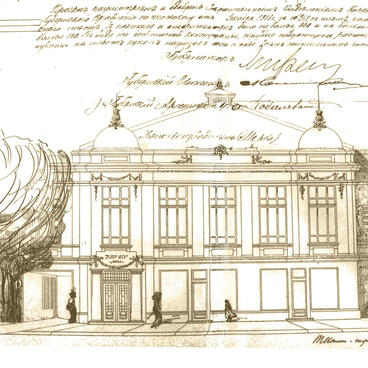The building, located at 61 Grazhdansky Prospekt in Belgorod, is now shared by the Belgorod Museum of Folk Culture and the bookstore on the ground floor.
This house is one of the city’s historical sites. The exact date of its construction is unknown. Most experts believe it was built in the early 20th century, but it has since had several owners, each of whom has altered the external appearance and internal layout of the building. Today’s property consists of two architecturally different buildings united by a common facade in 1958.
The first landlord to be mentioned was the merchant of the 2nd guild, Semyon Matveyevich Lyamtsev. In 1870-1880 he was the city councilor, the mayor of Belgorod and an honorary magistrate, so the building met his high status. In 1888, Semyon Matveyevich passed away and the property was inherited by his son, Semyon Semyonovich, and later by his wife Antonina Feodorovna.
The house was apparently occupied by other owners before the Lyamtsevs. No.2 in the 5th quarter of the 2nd residential district (the former address) is first mentioned in the documents because of a two-story stone extension and a gallery from the side of the courtyard. It is known that in 1903 the Lyamtsev family occupied a small part of the building — five rooms on the first floor and two in the outbuilding with access to the yard. The rest of the rooms were rented out as shops and accommodation. Through alterations and rentals, the estimated value of the house rose from 4,000 to 5,000 rubles.
In March 1911, Ivan Nikolayevich Golev, a personal honorary citizen of Belgorod, became the new landlord, followed a year later by a respected Belopolye merchant Nikolay Romanovich Pivovarov, who traded haberdashery and manufactured goods in the city. Thanks to his popularity, the address became known among the townspeople as the House of Merchant Pivovarov.
The “Orion” cinema was opened here by the merchant Isakov, who rented the premises from Pivovarov.
During the Civil War, the famous building was used for party meetings, and in Soviet times it housed the Palace of Culture, the city theater, a dormitory for actors, the college for culture and education, and other institutions.
The copy was taken from the original postcard published at A.A. Weinbaum’s printing house in the early 20th century. The original postcard was given to the museum for copying by a Belgorod collector Anatoly Tkachenko.
This house is one of the city’s historical sites. The exact date of its construction is unknown. Most experts believe it was built in the early 20th century, but it has since had several owners, each of whom has altered the external appearance and internal layout of the building. Today’s property consists of two architecturally different buildings united by a common facade in 1958.
The first landlord to be mentioned was the merchant of the 2nd guild, Semyon Matveyevich Lyamtsev. In 1870-1880 he was the city councilor, the mayor of Belgorod and an honorary magistrate, so the building met his high status. In 1888, Semyon Matveyevich passed away and the property was inherited by his son, Semyon Semyonovich, and later by his wife Antonina Feodorovna.
The house was apparently occupied by other owners before the Lyamtsevs. No.2 in the 5th quarter of the 2nd residential district (the former address) is first mentioned in the documents because of a two-story stone extension and a gallery from the side of the courtyard. It is known that in 1903 the Lyamtsev family occupied a small part of the building — five rooms on the first floor and two in the outbuilding with access to the yard. The rest of the rooms were rented out as shops and accommodation. Through alterations and rentals, the estimated value of the house rose from 4,000 to 5,000 rubles.
In March 1911, Ivan Nikolayevich Golev, a personal honorary citizen of Belgorod, became the new landlord, followed a year later by a respected Belopolye merchant Nikolay Romanovich Pivovarov, who traded haberdashery and manufactured goods in the city. Thanks to his popularity, the address became known among the townspeople as the House of Merchant Pivovarov.
The “Orion” cinema was opened here by the merchant Isakov, who rented the premises from Pivovarov.
During the Civil War, the famous building was used for party meetings, and in Soviet times it housed the Palace of Culture, the city theater, a dormitory for actors, the college for culture and education, and other institutions.
The copy was taken from the original postcard published at A.A. Weinbaum’s printing house in the early 20th century. The original postcard was given to the museum for copying by a Belgorod collector Anatoly Tkachenko.



